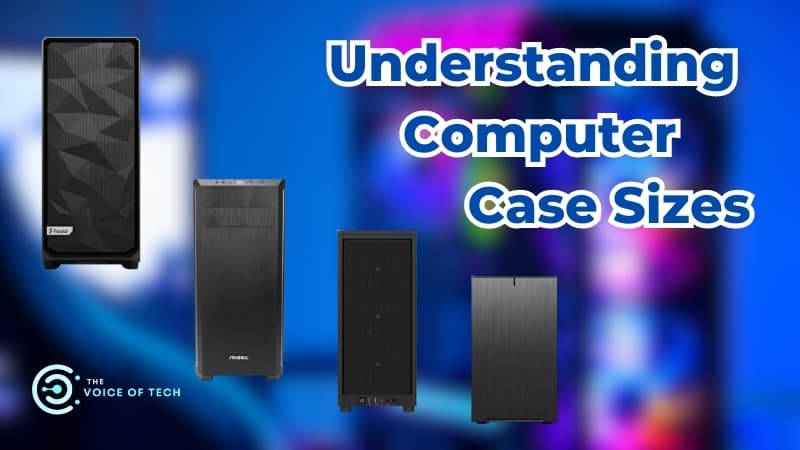
Expert Consulted: Adrian Gardiner. Years of experience buying both computers and computer parts for my own new customer builds has given me a keen eye for spotting great deals when shopping. In this article, I’ll be sharing my knowledge and tips with you to understand the subject of computer case sizes.
Computer case sizes have undergone a remarkable transformation over the last few decades, driven largely in more recent years by the gaming industry and also the pursuit of portability and space efficiency.
The computer case is the most visible part of your computer, so the correct choice of case, both in its size and appearance, is very important.
However, determining the case size is only the first step in your selection process.
The rest of this article goes into detail on computer cases, including their differences in size, what they look like, and the process involved in how you should choose the correct case size for your needs.
Related Article: MicroATX vs ATX Motherboard – Which is best?
Computer Case Sizes
The following image highlights a quick overview of computer case sizes. Please note these sizes are not exactly to scale. Cases from each format can vary in size tremendously.
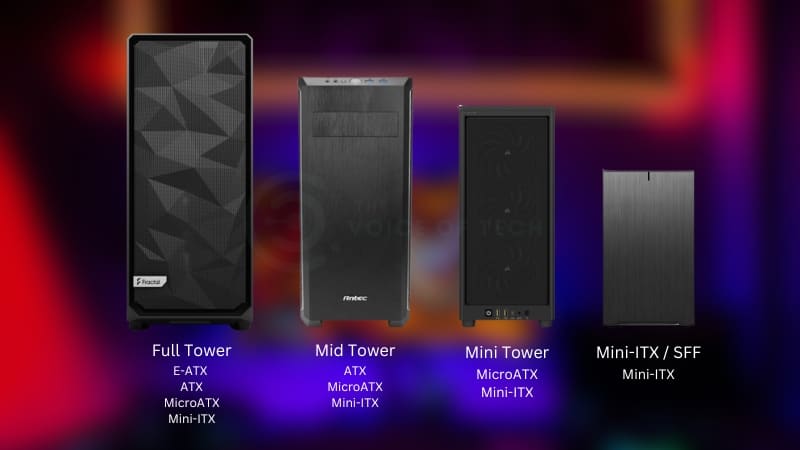
There have been many different case sizes over the years, many of which are no longer available.
Also, unlike motherboards, which are all a fixed standard size, the industry doesn’t seem to have a common understanding of what a standard case format is, with different manufacturers often choosing to interpret each size format in their own way.
Understanding Case and Motherboard Sizes
The motherboards that will fit each case format will, of course, vary according to the case size, but here is a quick guide to what you can expect:
| Case Format | Supported Motherboards | Approx. Height |
| Full Tower E-ATX | E-ATX ATX MicroATX Mini-ITX | 24″ |
| Full Tower ATX | ATX MicroATX Mini-ITX | 24″ |
| Mid Tower ATX | ATX MicroATX Mini-ITX | 20″ |
| Mini Tower | MicroATX Mini-ITX | 18 |
| Mini-ITX / SFF | Mini-ITX | 3-18″ |
These days, the most commonly sold case formats include the following four main sizes that cover most people’s needs. Starting with the largest format these are:
Full Tower – ATX or E-ATX
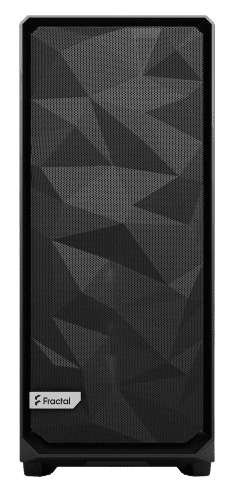
The Full Tower ATX (Advanced Technology Extended) or Full Tower E-ATX (Extended ATX) case was designed for specialist computer builds.
These were usually for gaming enthusiasts simply looking for increased space to house more components, like multiple graphics cards, extra storage drives, and additional cooling fans.
Expect enough room to fit just about anything you’ll likely need for the ultimate gaming set-up.
Their size means they are bulky and heavy, so take up a lot more room and, especially with all components fitted, can be tricky to manhandle and move around.
Motherboard Compatibility
All motherboard sizes will fit one of these cases, so there’s plenty of choice. There is a difference between ATX and E-ATX:
- E-ATX, ATX, MicroATX, and Mini-ITX (Full Tower E-ATX)
- ATX, MicroATX, and Mini-ITX (Full Tower ATX).
NOTE: Always check the case manufacturer’s dimensions for your chosen case.
Mid Tower – ATX
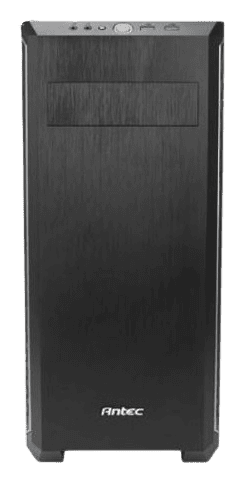
The Mid Tower is currently the most popular case format sold today, and while not as huge as the Full Tower case, it has plenty of room for most requirements, especially for gamers, and yet is still small enough to fit on a desk without looking out of place.
These cases are roomy enough to take all the usual key components, including multiple GPU setups and support for custom cooling arrangements. You can also expect room for great cable management options allowing for a nice, tidy build.
More room inside the case means you’ll have better ventilation and airflow, hopefully with less chance of dust buildup.
With the popularity of the Mid Tower case, the only problem you’ll have is the vast choice available with every conceivable design possible ready for your perfect and unique-looking gaming PC.
Motherboard Compatibility
The size of the Mid Tower case gives them great flexibility, and you’ll find that all cases smaller than E-ATX will fit nicely (you can also find the odd Mid Tower that can take an E-ATX motherboard:
- ATX
- MicroATX
- Mini-ITX.
NOTE: Always check the case manufacturer’s dimensions for your chosen case.
Mini Tower – MicroATX
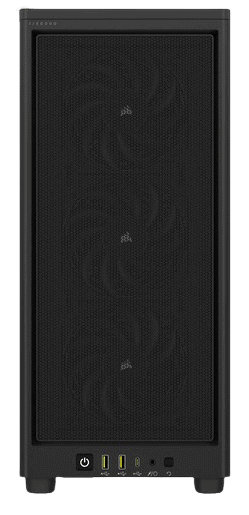
While smaller than Full and Mid Tower formats, the Mini Tower or MicroATX case is still usually large enough to fit graphics cards and various storage mediums and yet small enough to be placed in tight spaces – so long as you ensure good airflow all around the case.
These cases will also take an ATX power supply unit (PSU), although I recommend you check the PSU dimensions to be safe.
On a side note, the Mini Tower is the format often adopted by mainstream brands like HP, Acer, Lenovo, etc.
These smaller format prebuilt computers often are fitted out with bespoke components designed specially by manufacturers to ensure a smaller size computer and lower costs (for them).
Motherboard Compatibility
Again, like the Mid Tower case format, the Mini Tower or MicroATX case’s compact dimensions and internal flexibility make it a popular choice for gaming enthusiasts. These are the motherboards that will fit the Mini Tower case:
- MicroATX
- Mini-ITX.
Mini-ITX / Small Form Factor Case
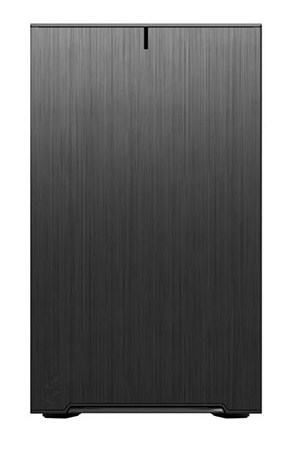
The Mini-ITX and small form factor (SFF) case format is designed with being compact in mind and is still a bit of a niche case size, although its popularity is on the rise.
Its main application would be for use as a Home Theatre PC (HTPC) as it’s small enough not to look out of place in a living room near your TV and home entertainment devices.
If needed, this type of case could easily be carried around.
Motherboard Compatibility
The Mini-ITX case can be used for gaming applications, but it would need careful component choice to ensure a) that everything fits nicely within its tight space confines and b) that it’s adequately cooled. The only motherboard that fits this type of case is:
- Mini-ITX.
How to Choose Your Case
With so many options available, from the size of the case to whether your motherboard will fit and what the case will look like, it can be quite bewildering to the newcomer.
Taking into account the three main case formats described above, to help with your selection process, here is exactly what you need to consider when choosing your new computer case:
- Case Colour: What color would you like? Computer cases usually come in black, but you can now get them in grey / silver, white, red, and a few other colors, depending on the case.
- Motherboard Size: What size of motherboard do you intend to fit? (This will largely dictate the size of your case – the most popular choice is either ATX or MicroATX if on a tight budget)?
- GPU Length: Measure your GPU if you already know which card you will use and find out what size GPU the case will take (i.e., length, especially after other fans have been fitted, which can further reduce available space)
- PSU Length: Check to see if your chosen PSU will fit the selected case (sometimes a drive cage can be removed to provide extra space for the PSU)
- CPU Air Cooler Height: Find out how tall your chosen cooler will be and check to see if it will fit (some can be very tall and may be too tall for the depth of the case)
- Cooling Fans: How many case cooling fans will you be fitting, and will the case come with any free-of-charge (larger case equals more space for more fans)?
- Ventilation: Does the case allow good ventilation, particularly at the front and ideally at the top, too?
- Fan Hub: Does the case come with a Fan Control Hub (group your fans together for better control and management of cooling fans)?
- Liquid Cooling: Will you be fitting an AIO (All-In-One) or a custom liquid cooling system (the case needs to support a custom cooling solution)?
- Rubber Grommets: Do pass-through holes have rubber grommets to protect to protect cables?
- Cable Management: Does the case have a good cable management system? (This can make a huge difference to the finished look of the case and improve ventilation by keeping messy cables out of the way.)?
- PSU Shroud: Does the case come with a power supply shroud (it keeps the inside of the case looking neat and tidy if you have a glass side panel – ideally, a ventilated shroud is best – also, is it removable for ease of installation)?
- Dust Filters: Are dust filters included (usually one underneath the PSU and at the front of the case?
- Expansion Slots: How many expansion slots does the case include?
- Captive Screws: Are captive screws used in the case (these screws don’t fall out when undone)?
- Front Connectivity: How many USB ports are there at the front, and of what specification, i.e., USB 2.0, USB 3.0, and Type-C, for example)?
Other considerations include:
- Glass Side Panel: Do you want a glass side panel (these are great for showing off the inside of your case and are usually either clear or have a darker tint)?
- Tempered Glass: If going for a glass side panel, make sure the glass is tempered (glass that has been specially heat treated to ensure it shatters into many small pieces instead of large dangerous shards of glass)
- LED Lighting: Are you looking for a case with LED lighting built in (some cases come with LED accent lighting, whereas others will come with LED fans built-in)?
- Tool-Free Design: Does the case come with tool-free options to make it easier to remove panels, etc. (this can make it much faster to put together)?
- Quality of Construction: What’s the quality of construction like (do you want a case built using high-quality steel or aluminum alloy)?
- Online Reviews: Check around online to see what online reviews left by other purchasers say about your chosen case.
- Warranty: What warranty comes with the case (many case suppliers now include a 2-year warranty)?
The above lists cover all the possible options you are most likely to have to choose from and won’t all apply in every case.
From my own experience in the industry, out of these four sizes, the Mid Tower is the most popular choice out there by far, closely followed by the Full Tower, so there is a good chance you’ll be needing one of either.
It’s worth noting that the actual dimensions of a case from each of the above formats will vary quite a bit, as will the shape. See our article on unique gaming cases to see what I mean.
There is no actual defined standard size for each format, except to say that each is a slightly larger format than the other but designed to fit a certain size of motherboard.
Therefore, when looking for a case, you’ll need to note the dimensions carefully.
Once you’ve decided on a particular case, check the dimensions to make sure it will fit where you want it to be located and that there is good space all around it for adequate ventilation.
NOTE: Sometimes, you’ll find certain case formats will fit a larger motherboard than expected, so it’s always worth checking their specifications carefully. It might mean you can get away with a smaller case for your computer build.
Conclusion
Computer cases come in 3 main formats, Full Tower, Mid Tower, and Mini Tower, with different-sized motherboards for each format.
Other case sizes are available, both larger than the Full Tower and smaller than the Mini Tower, but they are much harder to find and are generally not as popular.
There are quite a few things to consider when buying your case, and hopefully, our comprehensive list will help in that regard.
With so many amazing choices around, it’s a great time to build your own computer.

